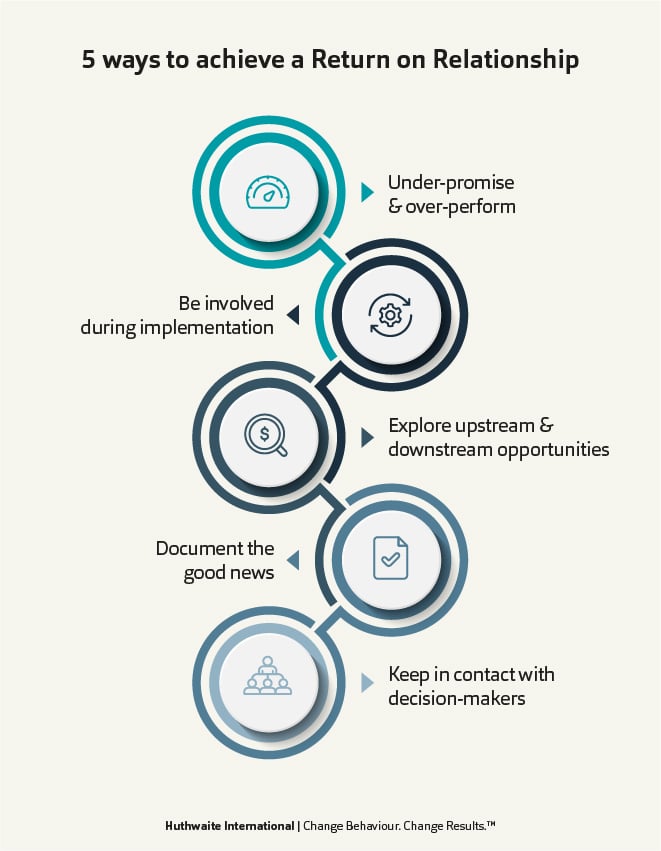In today's highly competitive marketplace, consumers have endless choices and can quickly switch allegiances. Building your customer needs to improve customer retention and prioritising a focus on Return on Relationship (RoR) have become more critical than ever.
We will delve into what helps sellers achieve a strong Return on Relationship (RoR), and actionable steps you can take today to achieve this.
What is Return on Relationship (RoR)?
Return on Relationship (RoR) is a term coined by Ted Rubin, a renowned social media strategist and speaker, to describe the value a business or individual derives from building strong relationships with their customers and followers.
RoR is a paradigm shift from the traditional Return on Investment (ROI) approach, which focuses on the monetary value of a transaction.
Instead, RoR places emphasis on the long-term benefits of investing time and effort in building genuine connections with people, leading to increased loyalty, trust, and customer advocacy.
How to utilise non-sellers to achieve a Return on Relationship (RoR)
Service as a resource
One way to maximise your RoR is to utilise non-sales resources as sales resources, where appropriate.
This includes ensuring you are communicating with your sales team and making sure that project managers are continuously updated on the account to help them understand the signs of change. By doing so, they can provide valuable insights and feedback to the sales team, which can help them to better meet the needs of the client.
It is important to note that this does not mean turning non-sellers into salespeople, but rather recognising when they may have valuable information to share and empowering them to do so. This approach can help build stronger relationships with clients and, ultimately, lead to a greater Return on Relationship (RoR).
Look out for signs of change
If we go back to the very beginning of the buying cycle, we can see that change is the agent that activates a new business opportunity. Always be on the lookout for change and consider what each change may mean for your customer and for you.
Remember to consider both internal and external change. A change of senior management, for example, may mean a change in strategy; that could open up new possibilities for you. Changes in the external environment through, for example, legislation or new competition, may have knock-on effects that could bring business your way.
Keeping lots of client contacts allows you to explore what is changing with a wide range of people. You should be in a position to spot likely needs arising from those changes early on and possibly even before the customer does.
This gives you the opportunity to work on these issues long before the competition gets involved and to put yourself in pole position for the sale ahead. If you have high-level contacts, who know and trust you, it might even be possible to discuss future business strategy and the impact it will have on the business.
This gives you the chance to explore how you might be able to help implement that strategy long before the business needs have filtered down through the organisation and the need for new products, systems, or services has been recognised.
Download your free copy of ‘Developing Long Term Profitable Relationships’ now and learn how to use non-sellers to maximise your Return on Relationship with customers.
Five tricks to generate significant Return on Relationship (RoR)
In today's fast-paced and highly competitive business environment, focusing on Return on Relationships has become more critical than ever to retain customers and drive business growth.
But how can you nurture strong connections with multiple clients at the same time?
To help you get started, we’ll explore five essential sales tricks to help nurture your potential clients into long-term partnerships.

1. Under-promise and over-perform
We have probably all heard people talking about new systems or equipment being installed in their organisation who have concluded early in the process that it is a waste of money and won’t work.
Change is often seen as a threat and people quickly latch onto setbacks, or problems, as proof that it isn’t going to work. Make sure all the people affected by the change understand the plan and how problems will be overcome, to stop the build-up of negative feelings.
Remember, negative feelings from the workforce will filter up to senior management, raising their concerns about the wisdom of the decision.
2. Stay involved during implementation
In many organisations, the seller moves on to the next sale once the business is won, leaving the implementation team to manage the delivery and installation of the solution.
This can be a mistake, since the seller will have built up knowledge of the account, its influencers, and decision-makers that no new team can have, no matter how good the handover briefing might be.
Knowledge of the account can be invaluable in planning a strategy for developing a long-term customer relationship. The accumulation of such knowledge may have taken many months, so it is a shame to waste it.
Where the seller does stay involved in the account, it’s natural to enjoy the moment of success. But, this is not a time to be complacent, as the effort put in during the implementation phase can pay rich dividends later.
Learn how account managers can work with customers to ensure a successful implementation, how to identify new opportunities for account development and how to protect your customers from your competitors with the ‘Developing Long Term Profitable Relationships’, whitepaper.
3. Explore upstream and downstream opportunities
Implementing something new in one department may have knock-on effects in others. This can create opportunities for further business.
For example, speeding up a process by introducing new equipment may increase demand for another process supplying materials or components.
The increased output could put more pressure on inspection, quality assurance, or the next process. All of which could provide opportunities for further sales.
Alternatively, senior personnel changes provide you with the perfect opportunity to reach out to existing clients. This is because when people move into a new, senior position, they may be looking to implement significant change. Make yourself known and show that your services are worth an introductory conversation.
4. Document the good news
During the sale, you will have set out the benefits your solution will bring. It is essential that your solution not only delivers those benefits, but is seen to do so.
It is unlikely the customer will make much comment about the benefits gained; all too often they simply take them for granted.
Check out exactly what benefits are being obtained and document these to all the key decision-makers and influencers, so they can see the return they are getting for their money.
Remember that it can often take time before the full benefits are obtained, as people need to adapt to new systems or equipment, so check progress from time to time and summarise any improvements gained.
Many salespeople complain that customers don’t appreciate the value they deliver; perhaps part of the problem is they fail to draw the customer’s attention to them.
Finally, documenting good news can help to offset any negative images that may have built up during implementation. With any complex project, there are bound to be some problems, it’s rare that everything goes according to plan.
Project implementation meetings typically have agendas full of issues that need to be resolved and the minutes of those meetings often summarise the problems and the agreed actions, so everyone knows about these well-documented difficulties. It’s important to counterbalance this perception by documenting the things that are going well.
5. Keep contact with as wide a range of decision-makers as possible
Documenting good news provides a perfect excuse to talk to senior people and to maintain the contact established during the sale.
All too often, we find that once implementation begins, client contact narrows and may be reduced to just the person managing implementation from the customer’s side.
We need to remember that times and people change, and a narrow range of contacts can make us vulnerable if those people change jobs or prioritise other projects.








.webp)